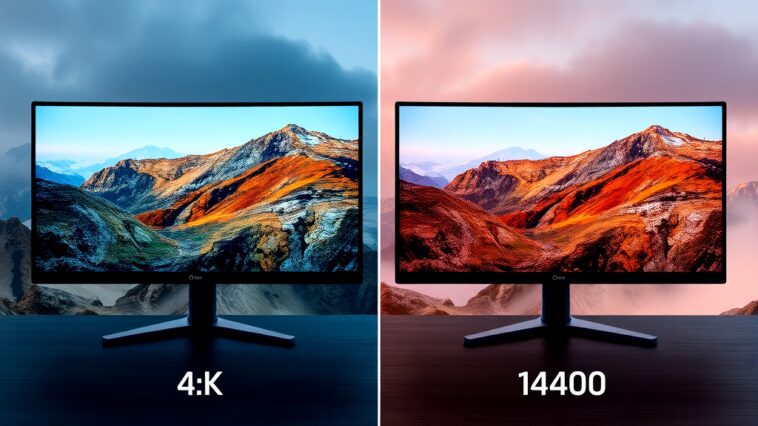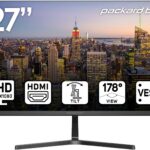When it comes to video editing, the monitor you use can make a huge difference in your work. With so many options available, two popular choices are 4K and 1440p monitors. But which one is better for video editing? In this article, we will explore the differences between these monitors, their benefits, and how to choose the right one for your needs. Let’s dive in!
Understanding Monitor Resolutions
First, let’s talk about what 4K and 1440p mean.
- 4K Resolution: This is also called Ultra HD (UHD). It has a resolution of 3840 x 2160 pixels. This means it has four times more pixels than 1080p monitors, which makes images look super clear and detailed.
- 1440p Resolution: This is also known as Quad HD (QHD). It has a resolution of 2560 x 1440 pixels. While it is not as high as 4K, it still offers a significant improvement over 1080p.
The Importance of Resolution in Video Editing
When you are editing videos, you want to see every detail. This is where resolution comes in. Higher resolution means more pixels, which can show finer details in your video.
- 4K vs 1440p Monitor Resolution for Color Grading: Color grading is a big part of video editing. With a 4K monitor, you can see more colors and details, making it easier to get the colors just right. But 1440p monitors also provide good quality, so it really depends on your needs.
Benefits of 4K Monitors Over 1440p for Video Editing
- Incredible Detail: The biggest advantage of 4K monitors is the detail they offer. This is super helpful when you are working with high-resolution footage.
- Better Color Accuracy: Many 4K monitors come with advanced color calibration, which is essential for professional video editing. This means you can trust that the colors you see on the screen are true to life.
- More Screen Real Estate: Working on a 4K monitor gives you more space to open multiple windows. You can have your editing software, previews, and other tools open all at once without feeling cramped.
- Future-Proofing: As technology advances, more videos are being produced in 4K. Having a 4K monitor means you are ready for the future of video editing.
4K vs 1440p Monitor Refresh Rates for Video Editing
Refresh rate refers to how many times a monitor updates the image per second. Higher refresh rates can make the experience smoother, especially if you are working with videos.
- 4K monitors often have refresh rates of 60Hz or higher, which is great for video editing and playback.
- 1440p monitors can also offer high refresh rates, but you might find more options in the 4K range.
Video Editing Performance: 4K vs 1440p Displays
When it comes to performance, both 4K and 1440p monitors have their pros and cons. Here are some things to consider:
- 4K monitors may require more powerful hardware to run smoothly. If your computer isn’t strong enough, it can slow down your editing process.
- 1440p monitors are less demanding, which means they might work better with older computers or laptops.
How to Choose Between 4K and 1440p Monitors for Video Editing
Choosing the right monitor for video editing can be tricky. Here are some tips to help you decide:
- Assess Your Needs: Consider what kind of video editing you do. If you work with high-resolution footage regularly, a 4K monitor might be worth the investment.
- Evaluate Your Budget: 4K monitors can be more expensive than 1440p monitors. Think about how much you can spend.
- Check Your Computer’s Specs: Ensure your computer can handle the demands of a 4K monitor. If it can’t, a 1440p monitor might be a better choice.
- Consider Screen Size: The larger the screen, the better you can see details. 4K monitors are often available in large sizes, but so are 1440p monitors.
4K Monitor vs 1440p Monitor for Professional Video Editing
For professional video editors, the choice between 4K and 1440p monitors can impact the quality of their work.
- 4K monitors provide the highest level of detail and color accuracy, which is crucial for high-end projects.
- 1440p monitors can still deliver great results at a lower price point, making them a solid choice for those just starting.
Impact of 4K vs 1440p Resolution on Video Editing Quality
When editing, the resolution of your monitor can significantly affect the quality of your work. Here’s how:
- 4K monitors allow you to see fine details, which can help you make better editing decisions.
- 1440p monitors provide a good balance between clarity and performance, especially for casual editors.
4K vs 1440p Monitors for Video Editing: Pros and Cons
Pros of 4K Monitors:
- Superior detail and clarity
- Better color accuracy
- Future-proof for upcoming video formats
Cons of 4K Monitors:
- Higher cost
- Requires more powerful hardware
Pros of 1440p Monitors:
- More affordable
- Less demanding on your computer
Cons of 1440p Monitors:
- Less detail and clarity compared to 4K
- May not be as future-proof
Color Accuracy in 4K vs 1440p Monitors for Video Editing
Color accuracy is key in video editing. A monitor that displays colors correctly can make a big difference in the final product.
- 4K monitors often have better color calibration options, allowing for more precise editing.
- 1440p monitors can also offer good color accuracy, but it varies by model.
System Requirements for 4K vs 1440p Monitors in Video Editing
Before you buy a monitor, consider your system requirements:
- 4K monitors typically need a more powerful graphics card and processor to run efficiently.
- 1440p monitors can work well with less powerful hardware, making them a good option for many users.
User Reviews on 4K vs 1440p Monitors for Video Editing
When deciding on a monitor, it’s always helpful to check user reviews. Many users have shared their experiences with both 4K and 1440p monitors.
- Users of 4K monitors often rave about the detail and color accuracy, especially for professional video work.
- 1440p monitor users appreciate the balance of performance and cost, making it a great option for hobbyists.
Long-Term Investment in 4K vs 1440p Monitors for Video Editing
Investing in a monitor is a big decision. Think about what you want in the long run:
- 4K monitors can be seen as a long-term investment due to their higher resolution and future-proofing.
- 1440p monitors can be a wise choice if you are on a budget or if you don’t need the highest resolution.
Conclusion
Choosing between 4K vs 1440p monitors for video editing ultimately comes down to your needs, budget, and computer capabilities. 4K monitors offer stunning detail and color accuracy, making them perfect for professional video editing. On the other hand, 1440p monitors provide a great balance of quality and affordability, ideal for those who are just getting started.
Take your time to assess your requirements, and remember that both options have their strengths and weaknesses. By considering the factors mentioned in this article, you can make an informed decision that will enhance your video editing experience. Happy editing!
Top 10 FAQs About 4K vs 1440p Monitors for Video Editing
1. What is the difference between 4K and 1440p monitors?
4K monitors have a resolution of 3840 x 2160 pixels, while 1440p monitors have a resolution of 2560 x 1440 pixels. This means 4K monitors show more detail and clarity in images.
2. Which monitor is better for video editing, 4K or 1440p?
4K monitors are better for video editing because they provide more detail and allow you to see finer aspects of your work. However, 1440p monitors can be good too, especially if you’re on a budget.
3. Do I need a powerful computer for 4K monitors?
Yes, you need a more powerful computer for 4K monitors. They require a better graphics card and more RAM to work smoothly. 1440p monitors need less power, making them easier to use with older computers.
4. Is it easier to edit videos on a 4K monitor?
Yes! 4K monitors give you more screen space to see details, making it easier to edit videos. You can have more windows open at once and watch your videos in high quality.
5. Can I use a 1440p monitor for professional video editing?
Yes, you can use a 1440p monitor for professional video editing. Many professionals use them because they are cheaper and still provide good quality for most editing tasks.
6. How does color accuracy compare between 4K and 1440p monitors?
Color accuracy can be similar in both 4K and 1440p monitors, but it depends on the specific model. Look for monitors with good color calibration features to ensure accurate colors for editing.
7. Do 4K monitors consume more power than 1440p monitors?
Yes, 4K monitors usually consume more power because they have higher resolutions. If you’re worried about electricity bills or heat, a 1440p monitor might be a better choice.
8. Is the price difference between 4K and 1440p monitors big?
Yes, 4K monitors are generally more expensive than 1440p monitors. If you’re on a tight budget, 1440p monitors can still offer great performance for video editing without breaking the bank.
9. Can I watch 4K videos on a 1440p monitor?
You can watch 4K videos on a 1440p monitor, but they will be downscaled. This means they won’t look as sharp as they do on a 4K monitor, but they will still look good.
10. Which monitor should I choose for gaming and video editing?
If you want to do both gaming and video editing, a 1440p monitor might be the best choice. It offers a good balance of quality and performance for both tasks, while 4K can be great for video editing but may not perform as well for gaming, especially on less powerful systems.





